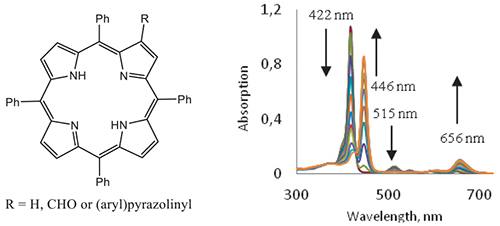Журнал "Макрогетероциклы"
Navigation
News
Impact Factor 2021 = 1.200 has been issued by ISI Web of Knowledge (JCR 2021).
Search
ISSN 1998-9539
Protonation of meso-Tetraphenylporphyrin and Its β-Functionalized Derivatives by Photogenerators of Acidity in Toluene and Polymer Film
Valerii F. Traven,a@1 Nuno M. M. Moura,b@2 Svetlana B. Scachkova,a M. Amparo F. Faustino,b El Mostapha Rakib,c José A. S. Cavaleiro,b Sergei M. Dolotov,a Ivan V. Ivanov,a Dmitrii A. Cheptsov,a and M. Graça P. M. S. Nevesb
aD.I. Mendeleev University of Chemical Technology of Russia, 125047 Moscow, Russian Federation
bQOPNA and LAQV-REQUIMTE, Department of Chemistry, University of Aveiro, 3810-193 Aveiro, Portugal
cLaboratory of Organic and Analytic Chemistry, Faculty of Sciences and Technics, Sultan Moulay Slimane University BP 523, 2300 Beni-Mellal, Morocco
@1Corresponding author E-mail: valerii.traven@gmail.com
@2Corresponding author E-mail: nmoura@ua.pt
DOI: 10.6060/mhc191175t
Macroheterocycles 2019 12(4) 356-363
The interaction of free-bases and Zn(II) complexes of meso-tetraphenylporphyrin, and its β-functionalized derivatives with photogenerators of acidity (PGAs, hexachloroethane or tribromoethanol) has been studied in toluene and also embedded in polymer films. The free-bases undergo fast reversible protonation during the irradiation procedure. The photoprotonation of free-bases by PGAs is accompanied by the fluorescence decay of each porphyrin substrate. The relative rates of such photoprotonation of free-base porphyrins depend to a certain extent on the porphyrin structure. The similar protonation and the fluorescence decay of the meso-tetraphenylporphyrin derivatives in the presence of PGAs also take place in a polymer film. The related Zn(II) complexes undergo photolysis under the conditions used with the fluorescence decay as well. The protonation and sharp fluorescence decay of meso-tetraphenylporphyrin derivatives during their irradiation can find application in photosensory technologies, information optical recording and antibacterial phototherapy.

| Attachment | Size |
|---|---|
| mhc191175t.pdf | 1.55 MB |
| mhc191175t_supp.pdf | 9.83 MB |
- 1243 reads
- Русский
